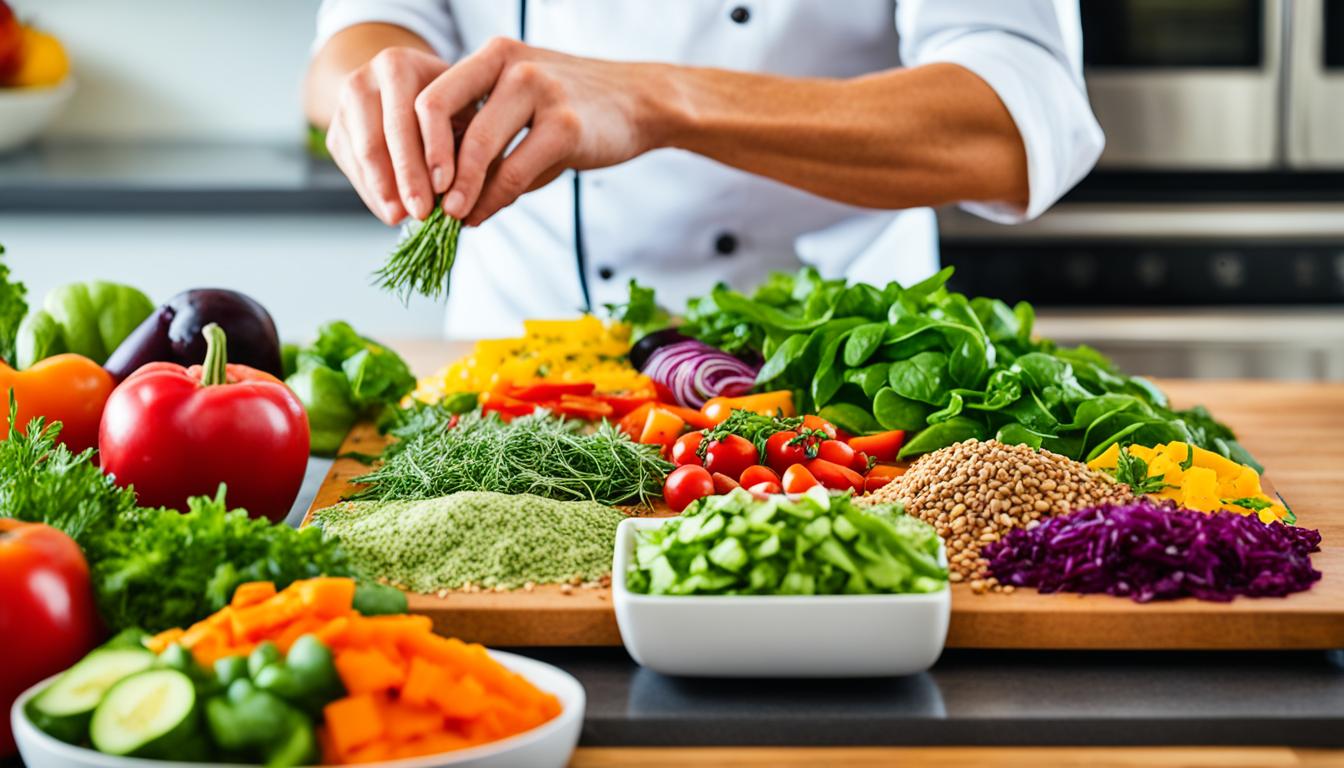Understanding the basics of healthy cooking is key to wellness and a balanced diet. By adopting these techniques, you can boost nutrition and cut down on unhealthy additives in your meals. This knowledge lets you prepare meals that support your health and well-being. Whether you’re a beginner or looking to improve, learning to cook nutritious meals can change your daily eating habits. We’ll show you how to cook mindfully, introducing you to methods that support clean eating.
Key Takeaways
- Healthy cooking techniques focus on preserving nutrients while minimizing unhealthy ingredients.
- Mindful meal preparation can enhance wellness by promoting better digestion.
- Steaming and boiling are great methods for nutrient retention, particularly for seniors.
- Using roasting, baking, and grilling can help maintain a healthy weight.
- Personalized recipe options can be found on platforms like Rewire Health.
- Culinary medicine emphasizes cooking practices that support overall health.
- Incorporating a variety of nutrient-dense foods into your meals is crucial for balanced nutrition.
Understanding Healthy Cooking Basics
Preparing your own meals is a pivotal step in enhancing your health journey. It gives you full control over the ingredients, ensuring your meals are not only fresh but also healthier. With the growing reliance on take-out and pre-prepared meals, it’s essential to understand the significance of cooking at home. This practice significantly boosts your well-being.
Importance of Preparing Your Own Meals
Preparing your own meals is not just about nourishing your body; it’s about living a vibrant lifestyle. By cooking at home, you steer clear of the additives often found in processed foods. You can opt for whole, nutrient-rich ingredients, which are key to Healthy Eating and better dietary habits. This approach encourages creativity and gives you a sense of fulfillment, empowering you to make health-conscious choices.
How Cooking at Home Affects Your Health
Home cooking offers more than just quality ingredients. Research shows that diets heavy in ultra-processed foods can raise the risk of chronic diseases like heart disease and type 2 diabetes. On the flip side, eating more meals prepared at home can lower these risks and enhance mental health. By focusing on Home Cooking Benefits, you lay the groundwork for improved health and a longer life.

Healthy Cooking Techniques
Exploring various Healthy Cooking Techniques can significantly enhance your nutrition. Different cooking methods impact both flavor and nutrient retention in your meals. These techniques ensure a balanced diet and allow you to enjoy delicious food while preserving its natural benefits.
Steaming for Nutrient Retention
Steaming is a top choice for Nutrient Retention. It helps preserve essential vitamins and minerals in vegetables, ensuring you benefit fully from your meals. This method uses low temperatures and minimal water, offering vibrant flavors without unhealthy fats. It’s perfect for health-focused kitchens.
The Benefits of Broiling
Broiling is a fast and effective way to reduce excess fats. Under high heat from above, fats drip away, lowering calorie content. Health organizations like the American Heart Association endorse this method. It’s ideal for meats, offering a healthier alternative to frying.
Low-Fat Frying Methods
Low-Fat Cooking can be transformed with low-fat frying options. Techniques like air frying or using minimal oil produce a crispy texture while keeping calories low. Adopting these methods lets you enjoy fried foods without the drawbacks of traditional frying.
Fresh Ingredient Cooking
Cooking with fresh ingredients boosts the flavor and nutritional value of your meals. By choosing local produce, you support community farmers and eat food at its peak freshness. Seasonal cooking lets you enjoy tasty, nutrient-rich options.
Benefits of Choosing Local Produce
Local produce tastes better because it’s picked ripe and delivered quickly. This leads to a superior taste over items shipped long distances. By using fresh ingredients from local farmers, you help reduce carbon emissions and save resources. The Copperfield sources ingredients from top local suppliers like Fischer Family Farms Pork and True Stone Coffee Roasters.
Seasonal Ingredients for Nutrition
Seasonal cooking is great for your health. Foods in season are full of vitamins and minerals, making them more nutritious. Using fresh ingredients helps you make varied recipes and avoid processed foods with additives. Choosing seasonal produce supports a healthy lifestyle. Learn more about its benefits here.
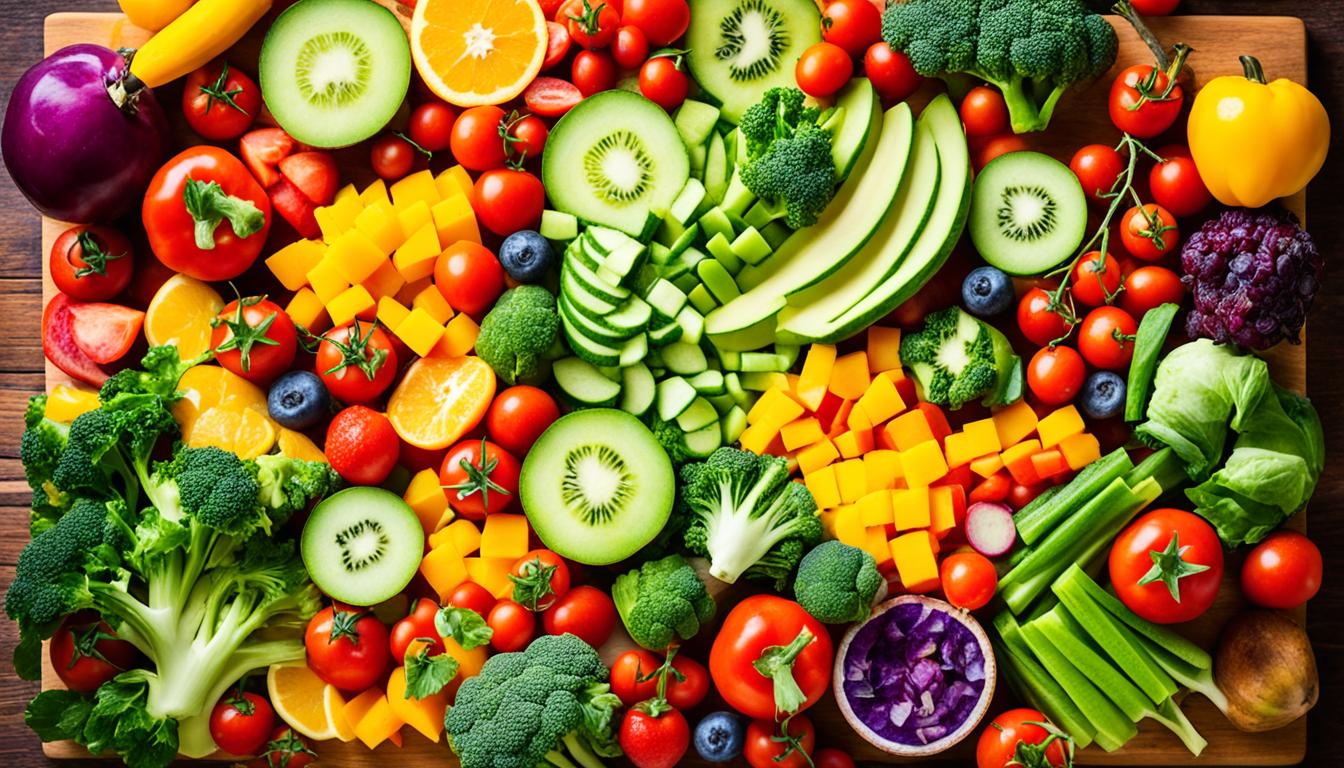
Nutritious Meal Preparation Strategies
Effective Nutritious Meal Preparation can transform your approach to healthy eating, making weeknight cooking easier. By focusing on planning Balanced Meals, you ensure every dish is both nutritious and fulfilling. Understanding the importance of Macronutrient ratios for proteins, carbohydrates, and fats is key to meal planning, leading to dishes that are well-rounded and nutritious.
Planning Balanced Meals
Start by dedicating an hour or two weekly to planning your meals and making a shopping list. Aim for a meal plan that prioritizes whole foods such as fruits, vegetables, legumes, whole grains, high-quality protein, and healthy fats. Using seasonal produce not only boosts flavor but also ensures you’re getting the most nutritional value at a lower cost. Remember to keep a list of staple foods ready. This practice helps reduce food waste and simplifies meal prep.
Batch Cooking for Busy Weeks
Batch cooking is essential for those with hectic schedules. It allows for quick access to healthy meals throughout the week. Using glass containers for storage keeps your meals visible and organized. Joining a community of people who also meal prep can offer motivation and accountability. Investing in quality food storage containers simplifies the process. Pre-portioning meals not only eases cooking but also helps maintain proper portion control.
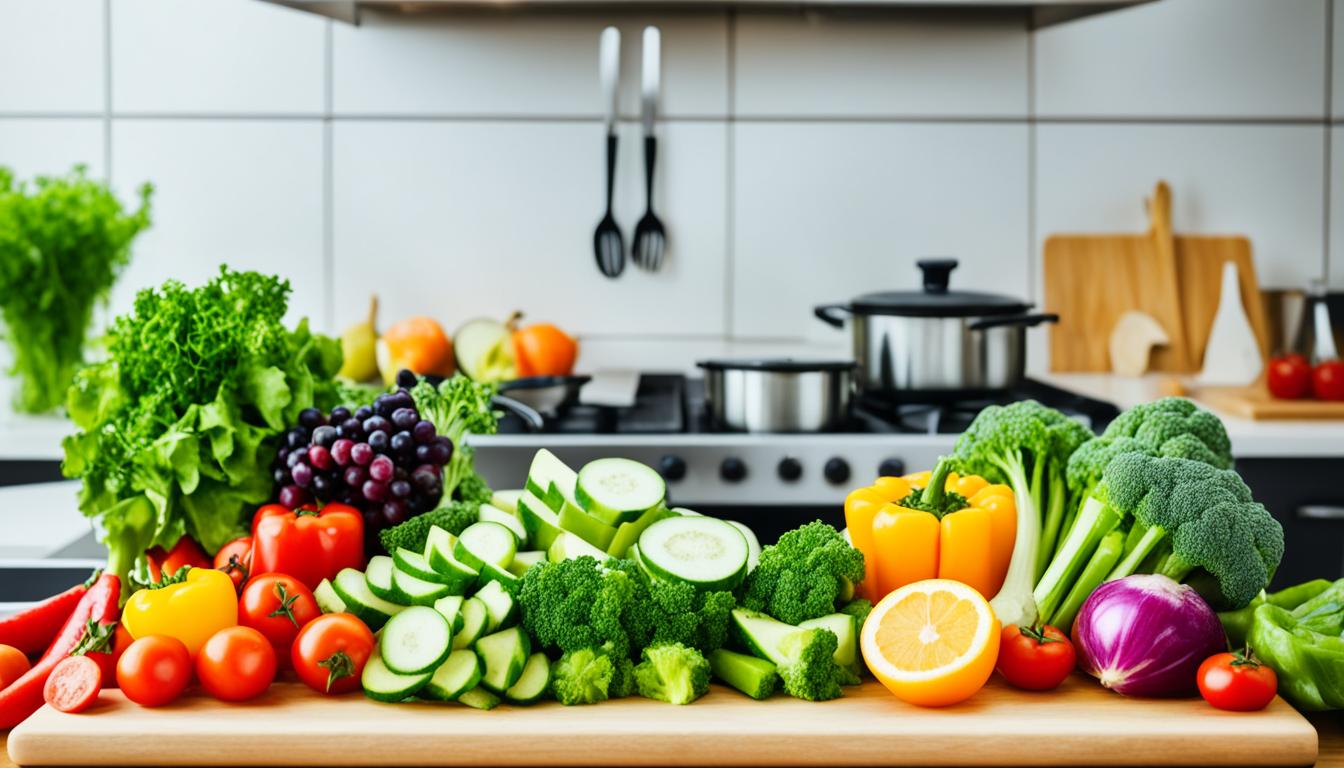
Heart-Healthy Cooking Methods
Your journey toward heart-healthy cooking involves making thoughtful choices in your kitchen. Focus on reducing saturated fats by incorporating nutritious options like olive oil and avocado. By adopting healthier cooking methods, you not only enhance your meals but also support your overall well-being.
Choosing the Right Oils and Fats
When it comes to heart-healthy cooking, selecting the right oils is crucial. Opt for healthy fats, such as olive oil, which is rich in monounsaturated fats. These fats can help lower bad cholesterol levels. Include fatty fish in your diet, aiming for two 4-ounce portions each week to boost omega-3 intake.
For dairy, choose lower-fat alternatives, such as part-skim mozzarella and reduced-fat feta. Using evaporated fat-free milk to thicken sauces is another heart-smart choice.
Incorporating Whole Grains into Your Diet
Whole grains are essential for heart-healthy cooking. Aim to make half of your plate consist of fruits and vegetables to ensure adequate fiber intake. Fiber-rich foods aid digestion and support heart health.
Switching from refined grains to whole grains, like brown rice and quinoa, can boost the nutritional value of your meals. Opting for fresh or frozen produce over canned options also improves your diet’s quality. For more insights on meal planning, check this resource.

Clean Eating Recipes to Try
Embracing clean eating opens the door to a variety of nourishing meals crafted from simple, whole ingredients. With an impressive selection of 53 clean eating recipes at your disposal, you can explore diverse dishes that prioritize health without compromising flavor. These recipes invite you to create healthy dishes that not only satisfy your taste buds but also contribute to your well-being.
Simple Ingredients for Healthy Dishes
Utilizing fresh, unprocessed foods is the cornerstone of clean eating. Ingredients such as goat cheese, tomatoes, and sweet potatoes shine in these recipes, elevating your meals to new heights. With flavors inspired by seasonal availability, you can expect to discover innovative combinations that make use of colorful vegetables like kale, asparagus, and brussels sprouts. Average kitchen time for these healthy dishes is around 40 minutes for dinner, with some meals taking just 15-20 minutes to prep for lunch.
Creating Flavorful Salads
Salads embody the essence of clean eating, allowing you to mix and match various ingredients to create flavorful salads. Consider incorporating chickpeas, almonds, and citrus fruits such as grapefruit and oranges for a refreshing twist. A Mediterranean-inspired salad featuring feta cheese, olives, and Italian herbs can be a delightful addition to your table. The balance of vibrant flavors and textures will make these salads not only nutritious but extremely satisfying. Embrace this approach, and your journey to clean eating will become both enjoyable and rewarding!
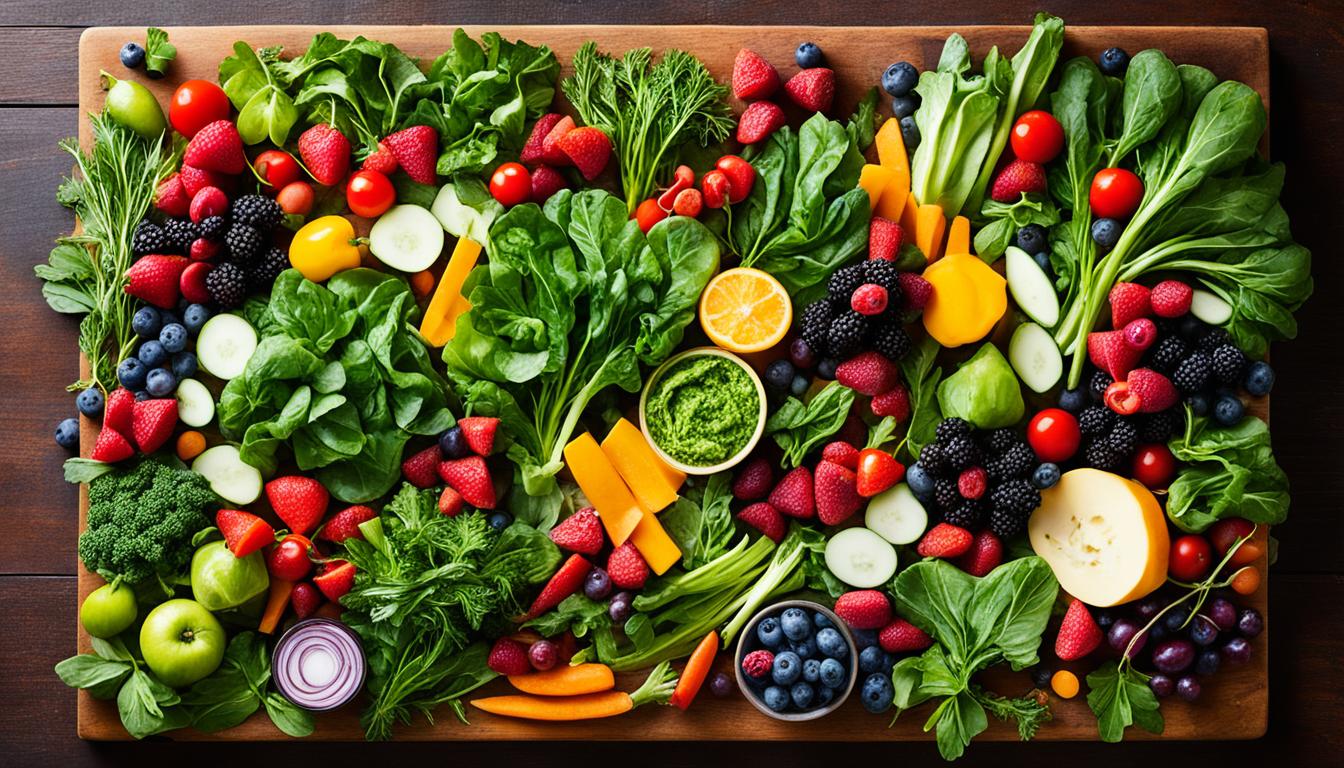
Low-Calorie Cooking Tips
Embarking on a low-calorie cooking journey can significantly enhance your health. By mastering Portion Control and Healthy Substitutions, you can craft meals that are both fulfilling and calorie-conscious. These strategies ensure your dishes remain flavorful yet nutritious.
Portion Control Techniques
Effective Portion Control is key to preventing overeating and fostering meal mindfulness. Utilizing smaller plates tricks the eye into perceiving a more abundant meal, naturally curbing intake. Additionally, understanding serving sizes is crucial for managing calories. For instance, a 1,500 calorie diet limits fat calories to 525, translating to about 58 grams daily. This knowledge guides your cooking methods, ensuring they align with your dietary goals.
Oven roasting is a prime example of a technique that allows fat to drip away, enhancing both the health and taste of your meals.
Substituting Ingredients for Health
Healthy Substitutions can revolutionize your cooking, ensuring it remains satisfying yet healthier. Swapping fat-free sour cream for regular sour cream, for example, reduces calories without diminishing flavor. Similarly, applesauce for butter in baking or cooking slashes fat content, ideal for a healthier option. Switching to fat-free milk or reduced-fat salad dressings in beverages also aids in calorie reduction.
Adding fresh herbs towards the end of cooking amplifies flavor without the calorie load often found in rich sauces.
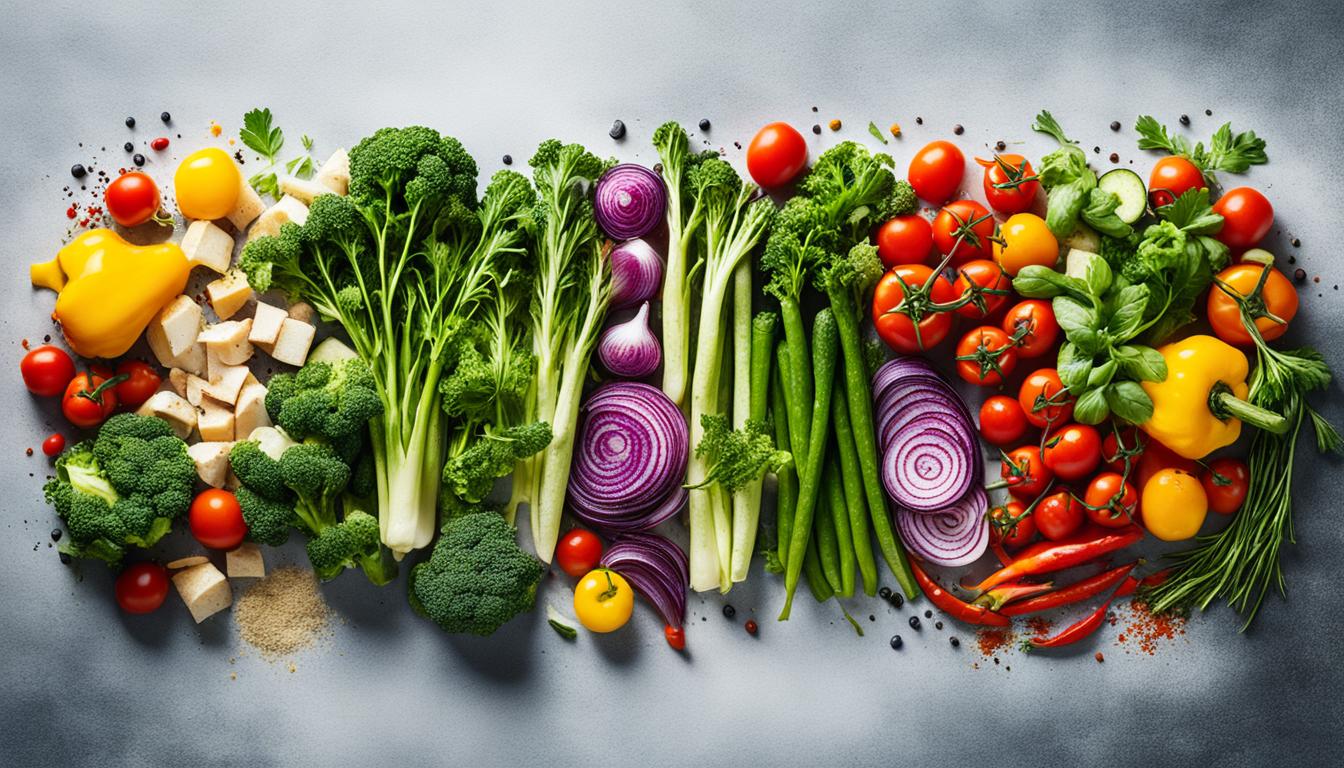
Balanced Meal Techniques
Creating nutritious dishes requires understanding key concepts like macronutrient ratios. This ensures your meals provide essential nutrients. A well-balanced meal typically includes three fundamental components: a whole grain or high-fiber starchy carbohydrate, a protein source, and at least one portion of fruits or vegetables. Striving for a variety of colors on your plate not only enhances aesthetics but also maximizes nutrient intake. This encourages you to reach the goal of five portions of fruits and vegetables daily.
Understanding Macronutrient Ratios
Recognizing the roles of different macronutrients—carbohydrates, proteins, and fats—empowers you to assemble healthy plates. For instance, combining lean proteins like grilled chicken or poached fish with an array of colorful vegetables not only fosters a balanced meal. It also helps reduce saturated fats. Opting for low-fat dairy products can support your protein intake while delivering vital vitamins and minerals.
Combining Proteins and Vegetables for Balanced Plates
When planning your meals, incorporate convenient ingredients such as frozen peas and supermarket own-brand whole grains. These can be both affordable and nutritious. Batch cooking makes it easy to prepare staples like chili, which provide satisfying leftovers. Utilizing pureed beans in soups can add creaminess without unnecessary fats, while choosing healthy cooking methods enhances flavor without compromising health. By integrating these balanced meal techniques into your routine, you can enjoy delicious and nourishing meals every day.
FAQ
What are some healthy cooking techniques I can use at home?
How can preparing my own meals improve my diet?
Why is it beneficial to choose fresh ingredients for cooking?
What strategies can I use for nutritious meal preparation?
How can I cook heart-healthy meals?
Can you provide some examples of clean eating recipes?
What are some low-calorie cooking tips to keep in mind?
How do I create balanced meals?
Source Links
- Senior wellness through cooking techniques – https://www.liveivory.com/senior-wellness-through-cooking-techniques/
- Cooking Up Wellness Through Culinary Medicine, With Olivia Thomas | Functional Medicine Coaching Academy – https://functionalmedicinecoaching.org/podcast/olivia-thomas-66/
- Cooking Basics – Be Healthy PA – https://www.behealthypa.org/eat/cooking-basics/
- Healthy Eating 101: Nutrients, Macros, Tips, and More – https://www.healthline.com/nutrition/how-to-eat-healthy-guide
- Want to Cook Healthy? Try These Methods – https://www.health.com/nutrition/healthiest-cooking-methods
- The Do’s and Don’ts of Healthy Cooking Methods – https://www.henryford.com/blog/2019/05/healthy-cooking-methods
- Tips for Sustainable Cooking- Techniques and Benefits – https://cookingenie.com/content/blog/tips-for-sustainable-cooking-techniques-and-benefits/
- Why Using Fresh Ingredients Really Matters | The Copperfield – https://www.thecopperfieldmn.com/blog/3-reasons-why-using-fresh-ingredients-really-matters/
- No title found – https://larosachicken.com/The-Importance-of-Fresh-Ingredients-in-Food-Preparation
- Meal Prep and Cooking Tips – https://www.nutrition.gov/topics/shopping-cooking-and-meal-planning/meal-prep-and-cooking-tips
- 10 Meal Prep Tips Every Beginner Should Know – https://www.everydayhealth.com/diet-nutrition/meal-prep-tips-every-beginner-should-know/
- 23 Tips to Ease Meal Prep – https://www.healthline.com/nutrition/meal-prep-tips
- Heart-Healthy Cooking Tips – https://www.eatright.org/health/health-conditions/cardiovascular-health-heart-disease-hypertension/heart-healthy-cooking-tips
- Heart-Healthy Cooking Tips | Sutter Health – https://www.sutterhealth.org/health/heart/heart-healthy-cooking-tips
- 55 Recipes to Jump Start Clean Eating – https://www.tasteofhome.com/collection/clean-eating-recipes/
- Clean Eating For Beginners – https://greenhealthycooking.com/clean-eating-for-beginners/
- Avoid Wasted Calories With These Healthy Cooking Methods – https://www.altru.org/blog/2015/july/avoid-wasted-calories-with-these-healthy-cooking-methods
- Healthy Cooking and Snacking, Eat Right, NHLBI, NIH – https://www.nhlbi.nih.gov/health/educational/wecan/eat-right/healthy-cooking.htm
- 80 Tasty Low-Calorie Dinner Recipes Ready in 30 Minutes or Less – https://www.tasteofhome.com/collection/low-calorie-dinner-recipes-ready-in-30-minutes/
- Healthy cooking made easy – https://www.bhf.org.uk/informationsupport/heart-matters-magazine/nutrition/cooking-skills/healthy-cooking-made-easy
- Healthy Cooking Techniques | Goya Foods – https://www.goya.com/en/nutrition/healthy-cooking-techniques

